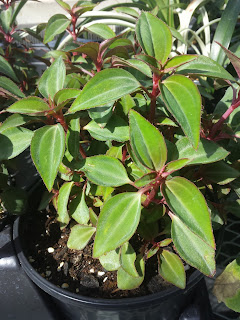Plant of the day is: Arthrostemma parvifolium or ???
Another species in the genus, Arthrostemma ciliatum, is called pinkfringe. I'm not sure if some variant could be applied to this species as well. I've got a nice crop of these right now, and I figured I'd get a little bit more information on their end size and more in depth cultural habits. So far they've been an easy going well mannered plant with an interesting rubbery feeling leaf. My leaves are quite a bit darker in color than pictures below, more purple. I wonder if it is sun exposure, nutrients, or just a genetic quality. The world may never know.
Sadly not any other CC images available (the one that is looks like it may be A. ciliatum). I shall take a few photos of mine and upload tomorrow.
Photo Credit: Andrés Ernesto Ortiz Rodríguez
Taxonomy, etc: It has been some time, if ever, that I have touched on a Melastomataceae. It is quite a family with some of the more spectacular species in the plant world, 2/3 of which are from New World Tropics). The Arthrostemma genus is quite small with 5-6 accepted species. This species is not widely known in cultivation and information is again fairly limited. I was trying for an easier species tonight, oh well. Wiki lists a publication of the species in 1823 while Tropicos reports it published in the Monographiae Phanerogamarum 1891. Type species for the genus is Arthrostemma ciliatum for which there is a bit more information. It has naturalized in Hawaii actually. Several melastomes (as they call them) are actually invasive, including the Tibouchina semidecandra (another great plant for a write up someday). A few other notables in the family include Melastoma, Medinilla, Osbeckia, and Rhexia (of which we have a native...there is the POTD reference :)).
Arthrostemma parvifolium (CC BY-NC-SA 4.0)
Photo Credit: Justin Lee
Description: Leaves are opposite and decussate (forming an x). You can see in the first photo how the leaves alternate positions up the stem in a kind of x like pattern. Flowers are perfect, and borne singly, a purple in color with a red hypanthium developing after the 4 petals drop (above). Looking at pictures around the web it looks like this species and A. ciliatum may get misidentified from time to time. As best as I can tell the leaves of A. ciliatum are typically greener and with much smaller teeth. Young stems are reddish, not radish. From the published description, again BHL you rock, it grows up to 3 dm (yeah...decimeter...) or .3m (I'm just not going to give you the foot, I won't). If you'd like to dig through a poorly translated Wiki description, here you go.
Several grown in 1 gallon container (CC BY-NC-SA 4.0)
Photo Credit: Justin Lee
Distribution/Culture: I can tell you thus far that it is handling quite a bit of sun and moisture this Spring. I think this will want a bit more shade as the intensity increases. Seems fairly tolerant of a wide ranges of soil pH and nutrition, haven't noticed any kind of chlorosis or nutrient deficiency with a moderate fertilizer regimen. Tropicos shows collections from Belize, El Salvador, Guatemala, and Mexico so it has a fairly broad range. Did you know you can even view the exact coordinates of these collections from google maps!? Check this one out! Give it up for a heck of a database.
A bit closer detail on margins, maybe starting to see some leaf burn from sun
(CC BY-NC-SA 4.0) Photo Credit: Justin Lee
That's all for tonight folks, I'll try to get those supplementary photos tomorrow. G'night.




No comments:
Post a Comment